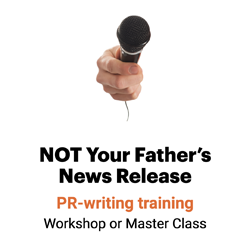Focus on the reader, not on PR 101 approaches
When Rachel McGrew, manager at Osborn Barr PR, wrote a press release about a client product, she didn’t rely on the PR 101 approaches she learned in college. Instead, she reimagined her release to write for the reader, not for fill-in-the-blanks PR conventions.

“We received way more coverage than we expected,” McGrew said. “We targeted several major national agriculture publications, and the release was picked up by all of them.”
Here’s how to write a press release that focuses on the reader:
1. Write about the reader in the headline.
We think the topic is the topic. But if you want to get read, make the reader the topic of every story.
Do focus your headline on what the reader will get out of the product, service, program or idea:
Farmers: Pen-and-paper crop scouting becomes obsolete
Don’t announce that you’re launching a new product, service, program or idea:
Rev!Co™ introduces new mobile crop scouting application
Bonus points: Grab attention by calling out to readers in the headline.
2. Introduce the product in the deck.
The deck, that one-sentence summary after the headline, is soon enough to focus on the product.
Do introduce and define the product and summarize what it will do for your readers:
New mobile application Rev!ID scouts, syncs and saves
Don’t mention partnerships, use hype words (revolutionize) or otherwise gaze at your navel:
Rev!ID Partners with SST Software to Revolutionize Crop Scouting
Bonus points: Rhetorical techniques like alliteration (scouts, syncs and saves) make display copy more eloquent.
3. Show in the lead.
One key to grabbing reader interest in the lead is to show instead of tell.
Do illustrate the problem you’re solving with your product, service, program or idea:
In 2013, tractors can practically drive themselves, and farmers tweet up to five times a day. But crop scouting is still done with pen and paper. This technology gap in the ag industry costs farmers and retailers time and money.
Don’t tell about the product, peppering the first paragraph with your brand name:
The new agriculture crop scouting application, Rev!ID, hit the market last week with a revolutionary approach. Rev!ID is a mobile all-in-one tool that allows crop consultants, growers, retailers and field scouts to work independently or together from a single program. Rev!ID is the first mobile app that allows you to scout more than 300 crops and track/identify over 1,500 issue types.
Bonus points: At 40-words long, the final lead is much more accessible than the 61-word “don’t” version.
4. Tell in the nut graph.
Now that you’ve grabbed the readers’ attention by writing about his needs, explain how you’re going to solve that problem in the second paragraph, aka the “nut graph“:
Do write about what the reader will get, not about what you are selling:
Now crop scouting joins the digital age, thanks to a new software solutions company, Rev!Co™. With the company’s scouting application, Rev!ID™, farmers and their retailers the can electronically scout and record common crop issues. In real time. …
Don’t write about the partnership or pat yourself and your colleagues on the back with adjectives like innovative and influential:
The use of mobile technology in the field continues to rise, and Rev!ID joins forces with some of the most innovative and influential information technology companies in the world. Among them is SST Software, the leader in agriculture information management.
5. Focus on people, not things.
It’s the rare reader who cares about what went into the sausage. Instead of focusing on the technology, show your clients using the product, service, program or idea in the field.
Do write about people doing things:
Users can take pictures of scouting events with their mobile device, create field-specific reports and email results to retailers, applicators and growers.
With this tool, users can cross-check photos and diagnoses from the palm of their hands.
Don’t write about the technology behind the stuff:
Rev!ID leverages the power of the SST agX issue and crop taxonomy data. In addition, a revolutionary feature is Rev!ID’s field boundary integration.
6. Use creative techniques.
Creative elements help readers “see” your point.
Do use metaphor, alliteration and other creative devices:
Rev!ID also uses its own “Wiktionary” photo and reference tool to harness the power of groupthink.
Don’t rely on just the facts, ma’am:
With Rev!ID, we integrate a retailer or consultant’s existing SST Summit field boundaries so the scouting information is captured on one set of field records.
7. Lift ideas off of the page with display copy.
News releases still look pretty much the same way they did when Ivy Lee invented the release 106 years ago: like one long river of gray text.
Do make your release more scannable with subheads …
Rev!Co partners with SST Software
Geared for success
… and callouts:
With its powerful tools and timesaving functionality, Rev!ID enhances the value of field scouting in the 21st century.
Don’t leave out the display copy. Readers don’t want to wade through a river of unbroken text.
Read the full release, before and after.
How can you reboot your release to increase interest and coverage?

Superb advise, as always.
The challenge in practice is getting clients or company managers who approve copy and who have outdated writing technique opinions, to allow fresh, more effective approaches. For many, change is scary. They may also mistakenly believe they’re the writing experts!
Agreed, Ford! What are your approaches to help reluctant clients see the light?
Its somewhat easier playing the “expert card” when on the agency side by gently reminding the client they’re paying for your expertise and really do have their best interests at heart. I once mentioned to a tech client that I didn’t tell him how to design circuits and he got it. The most challenging approach was writing the news release two ways and testing it with a couple of friendly Journalists (resorting to higher authority), who sided with our recommendations. ‘Suggest not trying that very often. I’ve sometimes felt like asking clients if they argue with their legal counsel, physician or accountant?
Teaching PR to your client and/or management team members is never-ending and often arduous. Just when you get them well-trained, they leave and you start all over.
Working inside a company as a PR staffer or manager can put you at a greater disadvantage since you’re often dealing with people further up the corporate totem pole (CEO, vp’s, directors) who are used to getting their way and/or not taking advice from “underlings” even though they allegedly hired you for your expertise in the first place.
Frankly, if a PR client is consistently not taking advise, its probably time to look for a replacement. This is addressed in two chapters in my new book, “Savvy Tech PR” – https://www.amazon.com/dp/1457552523 and elsewhere.
An applicable joke: What’s the difference between an engineer and a doctor? Engineers THINK they know everything. Doctors KNOW they know everything. :)
I would add to this valuable advice to link from the press release to any original content on your website that would give reporters background or additional information.
This also helps to keep the press release short as you are not tempted to add too much background information, which would defeat the purpose of a short, crisp email release.
Good suggestions, Chris!
Excellent Ann, thank you.
The idea of a “press release” (one to the press) is obsolete in the direct to client/consumer environment today. We’ve got to understand the idea of a “Customer Release.”
You’ve put the details down here wonderfully. The technology and the road to market have changed dramatically, but the principles are timeless:
Sell to the buyer
Sell the benefits
Cut the BS
write a picture, not a tome
Thank you, Steve.
If I had a dollar for every time someone told me the news release was dead, I’d be retired and living in the Virgin Atlantic lounge at Heathrow by now, having someone bring me a glass of bubbly before my Thai foot massage and after my nap in the swinging egg chair.
The media still plays an outsized role in influence shaping — look no further than our president’s tweets for evidence — and to cut them out of a campaign seems short-sighted, or at least flavor-of-the-day-ish. Yes to the principles you outline. Yes to writing releases for readers, not just journalists.
But the release obsolete? No way.
Send me a dollar. I need a foot massage.